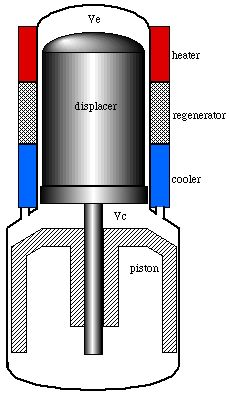I was reading the wikipedia page on RTGs and happened to stumble upon the section about efficiency. There were three methods that seemed to rely on direct conversion of thermal energy into electrical energy:
Then one which seemed keen on converting it from thermal, to mechanical and then to electrical:
The functioning of this generator can be summarized as found on the page:
Dynamic generators can provide power at more than four times the conversion efficiency of RTGs. NASA and DOE have been developing a next-generation radioisotope-fueled power source called the Stirling Radioisotope Generator (SRG) that uses free-piston Stirling engines coupled to linear alternators to convert heat to electricity. SRG prototypes demonstrated an average efficiency of 23%. Greater efficiency can be achieved by increasing the temperature ratio between the hot and cold ends of the generator. The use of non-contacting moving parts, non-degrading flexural bearings, and a lubrication-free and hermetically sealed environment have, in test units, demonstrated no appreciable degradation over years of operation. Experimental results demonstrate that an SRG could continue running for decades without maintenance. Vibration can be eliminated as a concern by implementation of dynamic balancing or use of dual-opposed piston movement. Potential applications of a Stirling radioisotope power system include exploration and science missions to deep-space, Mars, and the Moon.
A little more research on how Stirling generators function revealed the fact that, to function at all you need to maintain temperatures in two chambers, one hot and one cold. This allows for cyclic compression and the generation of energy through the movement of mechanical parts. To maintain this temperature differential for any prolonged period of time, a regenerator is also needed. The only heat-exchange systems that I have seen and am familiar with are quite macro in size. I'm also thinking that they may not work in a vacuum (I could be wrong here)!
A couple bits of information came from a question asked by uhoh more specifically a source in the answer linked to the question, located here, which states:
- Stirling hot-side temperature will be 350 ºC
- Stirling cold-side temperature will be -150 to 50 ºC
They also offer us a diagram as well (among many other cool things):
My main question comes in at this point:
As temperature management, dispersal and containment in a vacuum is significantly harder, does this present any problems for the SRG?
The paper mentions a lot about how the heated side will maintain its temperature, but only states:
- Fluid cooling loop to achieve 50 ºC cold end temperature.
Which leaves me to wonder:
- How will they manage to prevent the build-up of heat on the cool side while functioning in a vacuum?
- Something called a "micro scale regenerative heat exchanger" exists† is that's what is being used?
- I did not see anything like this in the diagrams on the source linked above.
- Is this generator not made to function in a vacuum-- but only in a near-vacuum environment?
† information on the Micro Scale Regenerative Heat Exchanger:
Another type of regenerator is called a micro scale regenerative heat exchanger. It has a multilayer grating structure in which each layer is offset from the adjacent layer by half a cell which has an opening along both axes perpendicular to the flow axis. Each layer is a composite structure of two sublayers, one of a high thermal conductivity material and another of a low thermal conductivity material. When a hot fluid flows through the cell, heat from the fluid is transferred to the cell wells, and stored there. When the fluid flow reverses direction, heat is transferred from the cell walls back to the fluid.
Even more can be found here: https://ntrs.nasa.gov/search.jsp?R=20040171485
Which even mentions:
A micro-scale regenerative heat exchanger has been designed, optimized and fabricated for use in a micro-Stirling device.

